From Ratios to Rates and Rates to Ratios

Basics on the topic From Ratios to Rates and Rates to Ratios
After this lesson, you will be able to solve problems involving ratios and rates, using tape diagrams and double number lines.
The lesson begins by recalling the definition of a ratio, in the context of a real-world scenario. It continues by demonstrating how to represent ratios with tape diagrams and double number lines, then use those tools to find the unit rate.
Learn how to convert ratios to rates, by helping Jill repair her chicken coop.
This video includes key concepts, notation, and vocabulary such as: ratio (a comparative, proportional relationship between two quantities); tape diagram (a tool used to visualize a set of equivalent ratios); unit rate (a proportional relationship which compares a quantity to one unit of another quantity); rate unit (the units used to measure a proportional relationship); and double number line (a visual representation of a ratio, in which the units are represented by two simultaneous number lines).
Before watching this video, you should already be familiar with representing ratios and equivalent ratios using tape diagrams and double number lines.
After watching this video, you will be prepared to find a rate by dividing two quantities.
Common Core Standard(s) in focus: 6.RP.A.2 A video intended for math students in the 6th grade Recommended for students who are 11-12 years old
Transcript From Ratios to Rates and Rates to Ratios
Jilll lives on a remote farm with her chickens. One cold day in January, a giant snowfall causes her chicken coop to collapse. Her chickens are freezing and, worse, Jill has run out of some of the supplies she needs to repair the chicken coop. Before she runs to the store, she figures out what she will need and what it will cost using ratios and rates. Let's take a closer look at what she will get. First, the nails. The nails cost 10 dollars for a 5 pound bag of nails. This information can be thought of as a ratio. Ratios tells us how much of one quantity there is compared to another. We write the RATIO of cost to weight of nails as 10 dollars to 5 pounds. She wants to buy one pound of nails. How much do nails cost per pound? We can use a tape diagram to answer this question. Let’s let one rectangle represent 5 pounds of nails. If each rectangle represents 5, how many rectangles do we need to represent 10 dollars? Two rectangles go on top, because 10 divided by 5 is 2. If we want to figure out how much one pound of nails costs, we can use the tape diagram to help us, by substituting in ones for the fives. We can then see that one pound of nails costs two dollars. This is a unit rate. The UNIT RATE is the ratio of how much of one quantity there is compared to ONE unit of another. In this case, we have two dollars to ONE pound of nails. The RATE UNIT tells us how we are measuring our quantities. In this case, we are measuring in dollars per pound. But what are nails without something to hammer them into? Let’s shop for the next item on the list, boards. The boards cost 2 dollars and 80 cents each. That's a unit rate of 2 dollars and 80 cents per one board. Jilll needs 10 boards. Let's figure out how much 10 boards will cost. Instead of using a tape diagram, we can just multiply both sides of the ratio by 10 so the price for 10 boards is 28 dollars. Let's look at the final item on Jilll's list, yarn. 350 yards of yarn costs 7 dollars. Which is a ratio of 350 yards to 7 dollars. Let's calculate the unit rate, which tells us how much yarn we get per dollar spent. Dividing both sides of the ratio by 7 gives us 50 yards per dollar. 50 is the unit rate, and the rate units are yards per dollar. In a similar fashion to the tape diagram, we can use a double number line to represent this unit rate. With a double number line, we have one number line representing the cost in dollars, and another number line representing the length of yarn in yards. Each tick on the number line representing the cost corresponds to the amount of yarn which can be bought for that price. So we can see from the double number line that 1 dollar gets us 50 yards of yarn 2 dollars gets us 100 yards of yarn and so on. The chickens are freezing. Jilll quickly goes shopping and then races home! She realized once she got back that, in her rush, she left the nails at the check out counter but she was able to find a solution using all the yarn she bought. Now the chickens are happily pecking in their winter wonderland!
From Ratios to Rates and Rates to Ratios exercise
-
Discuss ratios, unit rates, and rate units.
HintsSuppose that the prices of special chicken feed is $$ 3$ per pound. This can be expressed the ratio $$ 3:1~\text{lb}$. We know this is a unit rate because the second value in the ratio is $1$. The rate unit is dollars per pound.
Not every ratio is a unit rate. The ratio $6:2$ is not a unit rate, because the second value is $2$. In order to be a unit rate, the second value must be $1$. In this case, there are no units given with the ratio, so we don't know the rate unit.
Suppose the price of chicken fencing is $$ 9:2~\text{yd}$. This isn't a unit rate, but we know the rate unit is dollars per yard. We also know that if we change the order of the ratio to $2~\text{yd}:$ 9$, the corresponding rate unit is yards per dollar.
SolutionThe ratio $$ 10 : 5~\text{lb}$ shows us the cost of nails per 5 pound bag. This means that nails cost $$ 2$ per pound. $$ 2$ per pound is the $\text{unit rate}$. The $\text{rate unit}$ is dollars per pound.
The ratio $$ 2.80 : 1 ~\text{board}$ is already a $\text{unit rate}$ because it shows the cost of $1$ board. The rate unit is $\text{dollars per board}$. $$ 28.00 : 10 ~\text{boards}$ is an equivalent $\text{ratio}$, but it's not a unit rate. All unit rates feature a second term of $1$.
The ratio $350~\text{yd}:$ 7$ $\text{is not}$ a unit rate. Even though we don't know the unit rate, we still know the rate unit is $\text{yards per dollar}$. We can change the order of the ratio and write it as $$ 7 : 350~\text{yd}$. Now the rate unit will be $\text{dollars per yard}$. With ratios, unit rates, and rate units, order matters.
-
Calculate unit rate from a given ratio.
HintsIf we have a ratio like $12:4$, we can divide to determine the unit rate. $\frac{12}{4}=3$, so there are $3$ rectangles on the top and $1$ on the bottom, each with a value of $4$.
If we have a ratio like $100:20$, we divide to determine the unit rate of $5$. That means $5$ rectangles on the top with a value of $20$ each, and $1$ on the bottom, also with a value of $20$.
If we have a ratio of any two numbers and we want to find the unit rate of the first quantity to the second, we divide the first by the second. The result is the unit rate.
SolutionFor $$42$, Jill can buy $6$ bales of straw to line the her chicken coop. She only needs $1$ bail of straw. To determine the price, we divide $42$ by $6$ to get $7$. We can use a tape diagram to represent the ratio of dollars to bales. Each rectangle has a value of $6$. The unit rate is visible as the ratio of rectangles on top to bottom, giving us a unit rate of $$7$ per bale.
For $$75$, Jill can buy $15$ special heating lamps to install throughout the chicken coop. Jill doesn't want to buy $15$ lamps--how much does each cost? We can divide $75$ by $15$ to get $5$. We can use a tape diagram to represent the ratio of dollars to lamps. Each rectangle has a value of $15$. The unit rate is the ratio of rectangles on top to bottom, that is, $$5$ per lamp.
Super special treats forJill's chickens are in packs of $110$ for $$10$. How many will a dollar buy her? We can divide $110$ by $10$ to get $11$. Our tape diagram represents the ratio of treats to dollars. Each rectangle has a value of $10$. The unit rate is $11$ treats per dollar.
-
Identify the rate, the unit rate, and the rate unit.
HintsNot all rates are unit rates. A rate is a ratio of $2$ values, and neither of them have to be $1$.
For example, $\$5$ for $2$ gallons of gas is a rate, but it's not a unit rate. The unit rate would be $\$2.50$ per $1$ gallon. We know it's a unit rate because the second value is $1$.
In the above example:
rate: $\$5:2~\text{gallons}$
unit rate: $2.50$
rate unit: dollars per gallon
Sometimes we want to convert from a given rate to a unit rate:
If Dave drives $100$ miles in $2$ hours, his unit rate is $50$ miles per hour. The rate unit is miles per hour.
Sometimes we want to convert from unit rate to another, equivalent ratio:
If resoling a shoe costs $\$10$ per shoe, that's $\$ 20$ for $2$ shoes. The cost for $2$ shoes is probably more interesting to us than the cost per shoe!
The unit rate is always a number.
The rate unit is not a number, it's a unit composed of other units.
Some examples of rate units are:
- miles per hour
- dollars per pizza
- candies per dollar
- kilometers per gallon
SolutionSally is in first grade, and she's just starting to read. She reads $20$ words in $2$ minutes. $\frac{20}{2}=10$, so Sally reads $10$ words per minute. Yesterday she read $30$ pages!
- rate: $20$ words in $2$ minutes
- unit rate: $10$
- rate unit: words per minute
Ricardo eats $2$ apples per day. That's equivalent to $14$ apples every $7$ days. In two weeks he ate $28$ apples.
- rate: $14$ apples every $7$ days
- unit rate: $2$
- rate unit: apples per day
Janelle is a singer who uses vocal exercises to keep her voice in shape. This week, she exercised twice as many times as she did last week. In the future, she hopes to exercise about $21$ times per week, which means she needs to exercise about $42$ times every $2$ weeks.
- rate: $42$ times every $2$ weeks
- unit rate: $21$
- rate unit: times per week
-
Compare unit rates.
HintsTo convert a ratio to a unit rate, divide the first number by the second.
If the second unit is a decimal, we can multiply each number in the ratio in order to eliminate the fraction.
For example:
- $12:1.5$ features a decimal value of $1.5$
- We can multiply $12$ and $1.5$ by $2$, so that the ratio becomes: $24:3$
- $\frac{24}{3}=8$, so $8$ is the unit rate.
The world record for downhill skiing speed is 158.424 miles per hour.
Solution- cyclist: $\frac{50}{2}=25~\text{mph}$
- motorcyclist: $\frac{150}{3}=50~\text{mph}$
- general: $90:1.5=180:3=\frac{180}{3}=60~\text{mph}$
- cheetah: $80~\text{mph}$
- skiier: $\frac{2800}{20}=140~\text{mph}$
-
Represent ratios with a tape diagram.
HintsRemember that in a tape diagram, each rectangle has the same value, regardless of whether it's on the top or bottom row.
Remember, ratios can be reduced by dividing, or expanded by multiplying.
- $4:7$ is equivalent to $12:21$.
- $16:4$ is equivalent to $4:1$.
Solution- Count the number of rectangles on the top and bottom of the tape diagram to determine the ratio.
- Reduce the given ratios by dividing in order to compare them with the ratio of the rectangles.
-
Reflect on ratios, rates, unit rates, and rate units.
Hints- $8:3$ is a ratio.
- $21$ miles in $3$ hours is a rate.
- $7$ miles per hour represents a unit rate with rate units of miles per hour.
- $7$ kilometers in $3$ hours is a rate and a ratio.
- It's a rate because kilometers and hours are different units.
- $7:3.5$ is equivalent to $14:7$ because we can multiply each value in the original ratio by $2$.
- $14:7$ is equivalent to $2:1$.
Solution- All ratios are rates. False.
- All rates are ratios. True.
- All rates are unit rates. False.
- A unit rate is the same as a rate unit. False.
- Pounds per dollar and dollars per pound are both valid rate units/ True.
- To convert a rate to a unit rate, divide so the second value is $1$. True.
- If a marathoner drinks $12.5$ liters of water every $2.5$ days, then the marathoner drinks $6$ liters per day. False.

From Ratios to Rates and Rates to Ratios
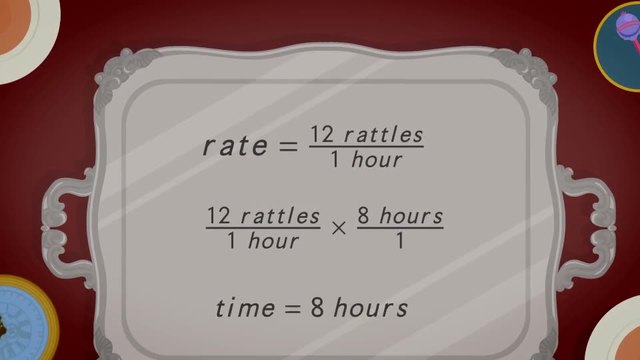
Finding Rates with Division
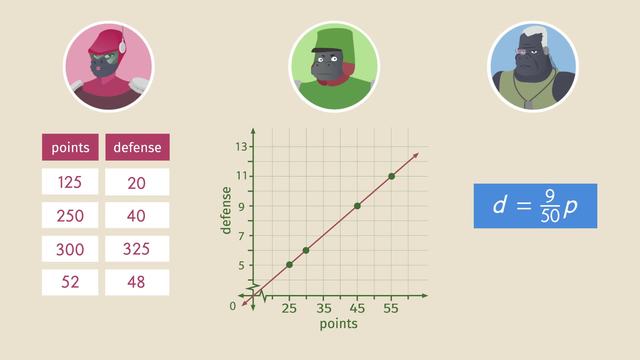
Comparison Shopping: Unit Price and Related Measurements

Getting the Job Done—Speed
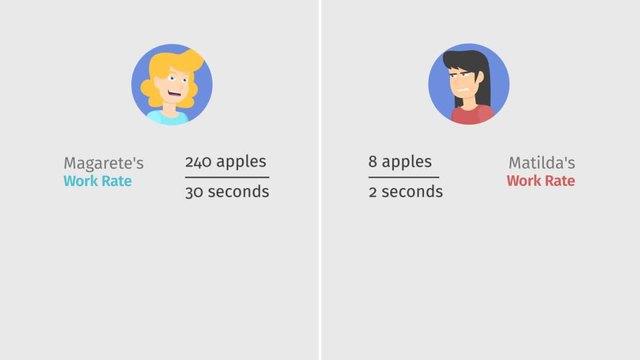
Getting the Job Done—Work
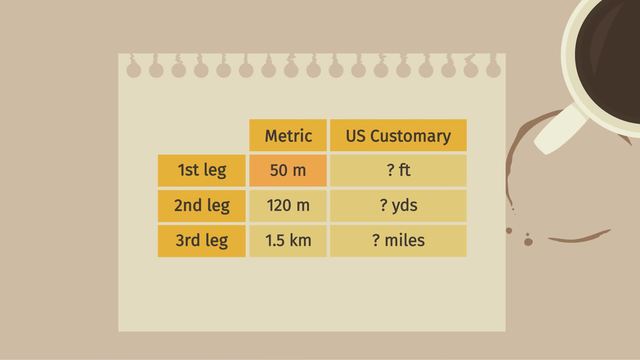
Getting the Job Done: Converting Units of Measurement
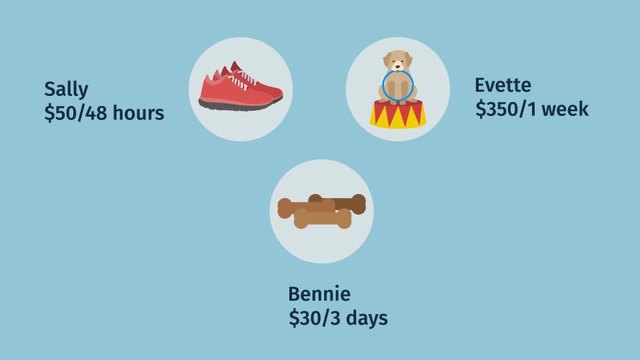
Problem Solving Using Rates, Unit Rates, and Conversions
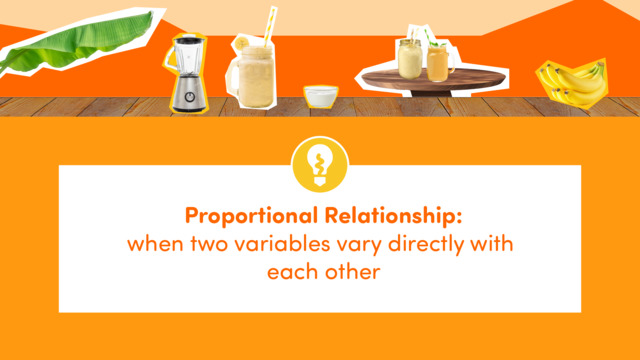
What is a Proportional Relationship?









I love. this
i like this